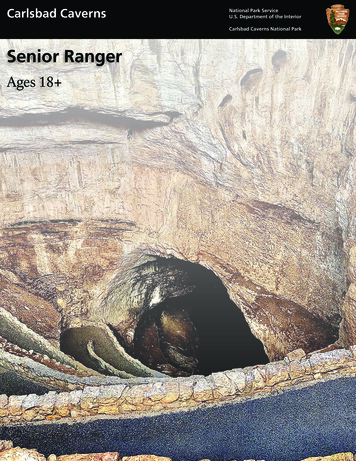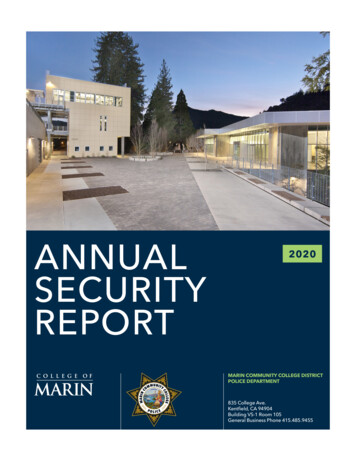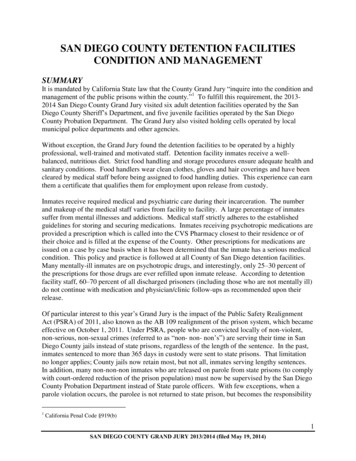
Transcription
Carlsbad CavernsNational Park ServiceU.S. Department of the InteriorCarlsbad Caverns National ParkSenior RangerAges 18
Welcome toCarlsbad Caverns National Park!Introduce Yourself!Name:Where are you visiting from?What is the closest national park to where you live?What is your favorite National Park Service site and why?Become a Senior Ranger by completing 10 of the 18 activities listed below in additionto What I Can Do? (page 17). Check the box next to each activity you complete. Whenyou are finished, take this booklet to the Information Desk to receive your SeniorRanger Pin.Activities 1. Preservation for Future Generations (page 1)2. What Does it Mean? (page 2)3. History of the Badge (page 3)4. Hidden Worlds: Park Film (page 4)5. Take a Hike (page 5)6. Cavern Development (pages 6–7)7. Winged Wonders (page 8)8. Those Who Came Before (page 9)9. Mapping a Cavern (page 10)10. Bonkers for Brochures! (page 11)11. What’s the Word? (pages 12–13)12. Reflections (page 14)13. Bat Bonanza (page 15)14. Interview a Ranger (page 16)15. Hike the Natural Entrance Trail16. Walk the Big Room Trail17. Attend a Ranger program or talk(Have ranger sign here)18. Pick up one bag of litter (see Information Desk for supplies)19. Drive the Desert Loop RoadRequired: What Can I Do? (page 17)COVER PHOTO: NPS / JANE BARNES
Preservation for Future Generations JANE BARNESWhat are five ways that we can all help preserve this beautiful resource forfuture generations?1.2.3.4.5.1
What Does It Mean?Find a picture of the National Park Service emblem and complete theone below.There are many different types of National Park Service (NPS) sites and not all havemountains or wildlife. There are now over 400 national park units throughout theUnited States. These include parks, battlefields, monuments, seashores, historic sites,recreation areas, memorials, and historical parks. They all have one thing in common—amission to conserve America’s cultural and natural resources.Match the parts of the NPS symbol with what they ation of natural scenic resourcesPreservation of plant lifePreservation of wildlifePreservation of historical and cultural resourcesPreservation of recreational resources
History of the BadgeThe arrowhead patch has remained the same all throughout the years.However, the badge has changed greatly. The badge has changed sixtimes over its history. Match the park badge with the correct year usingthe descriptions.1894–1906AThis first park badge was used in the first national park.1898–1906BThe second park badge is unique because at the time theForest Service was also managed under the Department ofthe Interior.1906–1920CThe third park badge retained its round shape and has aneagle on it.1920–1968DThe fourth badge was the first time our badge would nolonger be round. It changed to the federal shield design,but retained the eagle.1968–1970The fifth badge dropped the eagle which had been on thebadge since 1906. The round circle represents the sun.The two triangles represent mountains and the smalltriangles symbolize water surrounded by a pair of hands.EF1970–PresentThe sixth and final badge changed from silver to gold andgained a bison.NPS3
Hidden WorldsAnswer the following questions while watching the park film.1. True / False: The Big Room is the largest cave chamber in the world.2. How many caves are located within the park’s boundaries?a. 1c. 100 b. 50d. 200 3. What dissolved the limestone to make the caves?a. Sulfuric acidc. Waterb. Corn syrupd. Chlorine4. In what year did the major breakthrough-discovery in Lechuguilla Cave occur?a. 1898c. 1986b. 1923d. 19905. True / False: Carlsbad Cavern and Lechuguilla Cave are still being explored.6. What disease might the bacteria found in caves help cure?a. Polioc. Smallpoxb. Tuberculosisd. Cancer7. What species of bats live in Carlsbad Cavern?a. Vampire Batsc. Flying Foxesb. Brazilian Free-Tailed Bats d. Bumblebee Bats8. How far do bats have to fly through the Carlsbad Cavern each night before theyreach the surface?a. 0.5 kilometersc. 5 kilometersb. 1 kilometerd. 2 kilometers9. Animals come out at night to:a. Beat the heatc. Avoid predatorsb. Conserve waterd. All of the above10. Carlsbad Caverns National Park spans acres.a. 100c. 47,000b. 500d. 70,000 JANE BARNES4
Take a HikeWalk the 1/2 mile (0.8 km) Nature Trail at the east end of the parking lot. Ask apark ranger for directions.As you walk around, look at the diversity of plants that are native to theChihuahuan Desert. Use the signs along the trail to help you identify theplants below, using the word bank at the bottom of the page to help you.Write at least one thing you observed and one thing you learned abouteach Word BankChollaDesert WillowJuniperLechuguillaOcotilloPrickly PearSotolYuccaNPS / LAUREL MCKENZIE ILLUISTRATIONS5
Cavern DevelopmentMatch the numbers with the type of formations they represent, then answerthe questions on the following Lily PadsCave PearlsPopcornStalagmiteRimstone Dams6Soda StrawsNPS / DUSTIN BAKER ILLUSTRATIONS
Answer the following questions based on your observations inCarlsbad Cavern.Do you think that you can judge how old a cave formation is just by lookingat it (size, color, shape, etc.)? Why or why not?What methods might scientists use to achieve a better understanding of theage and formation process of a speleothem?How fast do you think speleothems grow? You may notice some formationsthat are only inches away from touching. Do you think they’ll meet in themiddle any time soon?All of the speleothems in Carlsbad Cavern are formed with the help of waterdepositing calcite. Does that mean all cave formations grow exactly the sameway? Choose two of the types of speleothems from the previous page andcompare and contrast the ways in which you think they formed.NPS / JANE BARNES7
Winged WondersCarlsbad Caverns National Park is home to many species of bats.However, these amazing creatures are often misunderstood. Decide whethereach statement below is true or false, then answer the questions at thebottom of the page.True / FalseBats are flying mammals.True / FalseBats like to live in peoples’ hair.True / FalseBats are helpful because some species eat a lot of insects.True / FalseAll bats have rabies.True / FalseLike mice, bats are rodents.True / FalseBats are blind.True / FalseAll bats are vampires that drink blood.What are some misconceptions you have had about bats? Have any of your opinions onbats changed after your visit to Carlsbad Caverns National Park? EMILY FLICKER ILLUSTRATIONS8
Those Who Came Before“Who discovered Carlsbad Cavern?” is a question that many visitors ask, but the realanswer is “we don’t know.” The human history of this area spans over 10,000 years.Although artifacts have not been found deep within Carlsbad Cavern, other artifactsnear the Natural Entrance suggest that Indigenous Peoples have known about and livednear Carlsbad Cavern for a long time. Even today, many tribes hold a deep connectionto this cavern.Watch the video Our Sacred Grounds in the exhibit hall to learn more aboutthe connections that several tribes have to this place and then visit theNatural Entrance. Using these resources, answer the following questions.From the video or the panel nearby, name at least four of the 14 tribes that acknowledgeaffiliations with Carlsbad Caverns National Park:How did the Mescalero Apache get their name?Why were the Guadalupes a place of refuge for the Mescalero Apache in the 1850s?Why is this region sacred to American Indians?When you visit the Natural Entrance of Carlsbad Cavern, look at the large naturalopening of the cavern and the surrounding landscape. Do you see any other evidenceof Indigenous Peoples nearby? Do you believe American Indians would have enteredCarlsbad Cavern? Why or why not?NPS9
Mapping a CavernCave surveying is an important task to help map and understand a cave.A survey team consists of three to four members, and one person is always incharge of sketching new passages. Imagine you are now a surveyor, in chargeof drawing a newly discovered room in Carlsbad Cavern. Use the key belowto add features to the room. Be sure to give your discovery a name!10 KELLI HOUSLEY
Bonkers for Brochures!You can answer all of these questions by getting a copy of the park map at theInformation Desk.1. Bats use echolocation to help them find prey.A. What is another reason that bats use echolocation?B. List at least two other animals that use echolocation.2. Where did the Brazilian Free-Tailed Bat get their name?3. True / FalseBats have fur.4. How many feet below the surface is Bat Cave?5. What proved to people that all the stories about the cavern were real?6. Carlsbad Cavern is located in which desert?7. What are three different animals that live in Carlsbad Caverns National Park?8. Why should you refrain from touching cave formations?9. Name another cave within the park that can be visited on a ranger-guided tour.10. How long in total is the self-guided tour (in time and miles)?11. At what depth is the deepest known part of Carlsbad Cavern?12. What did early visitors use to access the cavern before elevators and modern trails?11
What’s the Word?Using the information in the exhibit hall and the park brochure, solve thefollowing clues about Carlsbad Caverns National Park.Across2. So many unique fossils were found in this mountain range that a subsection of thePermian Era was named the Epoch.4. First discovered in the state of New York, White-Nose Syndrome is a thathas devastated hibernating bat populations across North America since 2006.6. Carlsbad Caverns National Park is located in the northern one-third of theDesert that extends into the U.S. The other two-thirds are located in Mexico.10. Bat was mined from Carlsbad Cavern due to its use as a fertilizer.11. Brazilian Free-Tailed Bats return to Carlsbad Cavern each summer to give birth andraise their young. Therefore, these bats are often referred to as a “ colony.”13. Cave are some of the few lifeforms native to this cave environment thatwe can see with the naked eye.15. In 2017, the lighting system in the cavern was replaced to help give a more naturallook and prevent growth.16. Distantly related to modern squids and octopuses, this fossil is frequently found inthe walls of Carlsbad Cavern.18. Cave formations are commonly formed from this type of mineral.Down121. On May 14, 1930, congress changed Carlsbad Cave National Monument toCarlsbad Caverns National Park, making it the United States’ designatedNational Park.3. Cave is the longest and deepest known cave system within the park. Morethan 150 miles have been mapped and surveyed so far.5. The cave systems in the Guadalupe Mountains are unique because they wereformed by acid (H₂SO₄) dissolution, rather than running water.7. In 1995, Carlsbad Caverns National Park was designated as a World Site.8. Jim is generally credited as the first person to extensively explore CarlsbadCavern.9. Like many caves, Carlsbad Cavern is primarily made up of this type of rock.12. An alternate name for “cave formation.”14. scrapers were stone tools flaked on both sides. Used by American Indians,this could be used as a knife, scraper, or ax depending on the need.17. A hand-stone used in conjunction with a metate by Indigenous Peoples to grindgrain or agave hearts.NPS / JANE BARNES
NPS / JANE BARNES13
ReflectionsPick a spot (in the cavern or on the surface) to sit quietly for a few minutes.Observe your surroundings and draw what you see in the space provided.Then answer the questions below.As you sit, look, and listen for evidence of life (in the cavern or the desert); do you see orhear anything? Why or why not?What kinds of life might be found here? What adaptations do you think life would needto survive in a cave or desert environment?Look around and listen again. Do you find any evidence of human impact around you?How might this human impact be negative or positive?We can help preserve our national parks by practicing Leave No Trace—leaving theseplaces as we find them, or better, so that others may enjoy them in the future. How areyou following the Leave No Trace ideals as you visit this national park?14
Bat BonanzaWhile watching to the bat video Echolocation: Listening in the Dark (locatedat the far end of the exhibit hall), circle the answers the following questions.Cave Myotis1. Echolocation is used to:a. Avoid obstaclesb. Find food while flyingc. Mate with other batsd. a and b2. True / False Bats are blind?3. Bats that eat bugs are called:a. Vegetariansc. Insectivoresb. Carnivoresd. Omnivores4. True / False : Bats help keep insect populations in check?5. What process similar to echolocation do we use to mapthe sea floor?a. Tetrachromacyc. Radiologyb. Sonard. GPS6. How long does it take for bats to gather datafrom echolocation?a. One minutec. A few minutesb. A couple secondsd. A few milliseconds7. Bats have had the ability to echolocate for:a. 10,000 yearsc. 50,000,000 yearsb. 20,000,000 yearsd. 60,000,000 years8. When do bats come out to feast on bugs?a. Sunrisec. 3:00 p.m. sharpb. Afternoond. Sunset9. Brazilian Free-Tailed bats prefer to eat:a. Mothsc. Fliesb. Beetlesd. MosquitosBrazilian Free-Tailed10. Large colonies of bats can consume how many poundsof insects each night?a. 1 poundc. 200 poundsb. 47 poundsd. 1,000 pounds EMILY FLICKER ILLUSTRATIONS15
Interview a RangerFind a park ranger or volunteer and ask them the following questions to getto know your public servants better. Don’t forget to introduce yourself!1. What are your duties with the National Park Service?2. What are some other types of jobs that park rangers do for the National Park Service?3. Have you worked at any other National Park Service sites? If so, which ones?4. What is your favorite part of your job?5. Why did you decide to become a National Park Ranger?Ranger Autograph:Now It’s Your Turn!1. If you were to become a park ranger, what typesof jobs would you like to do in our national parks?2. How can you help protect national parks even ifyou’re not a park ranger or volunteer?16
What Can I Do?Our Senior Ranger Motto is “Explore, Protect, Enjoy.” Answer the questionsbelow to explain how you can achieve these important goals.One way I can explore my environment at home is by:I can help protect plants, animals, and the environment near my home by:A place where I can go to enjoy the plants and animals near my home is:NPS / DUSTIN BAKER ILLUSTRATIONSenior Ranger PledgeI, , am proud to be a National ParkService Senior Ranger. I promise to explore, protect,and enjoy my national parks and the natural worldaround me. I will do my part to ensure that ournational parks and everything in them are preservedfor everyone, now and in the future, and I will sharemy knowledge of these special places with my friendsand my family.17
Certificate of Achievementhas successfully fulfilled the requirements of theSenior Ranger Program and is hereby proclaimed an officialDateCarlsbad Caverns National ParkSenior RangerPark Ranger
each statement below is true or false, then answer the questions at the bottom of the page. True / False Bats are flying mammals. True / False Bats like to live in peoples' hair. True / False Bats are helpful because some species eat a lot of insects. True / False All bats have rabies. True / False Like mice, bats are rodents.











